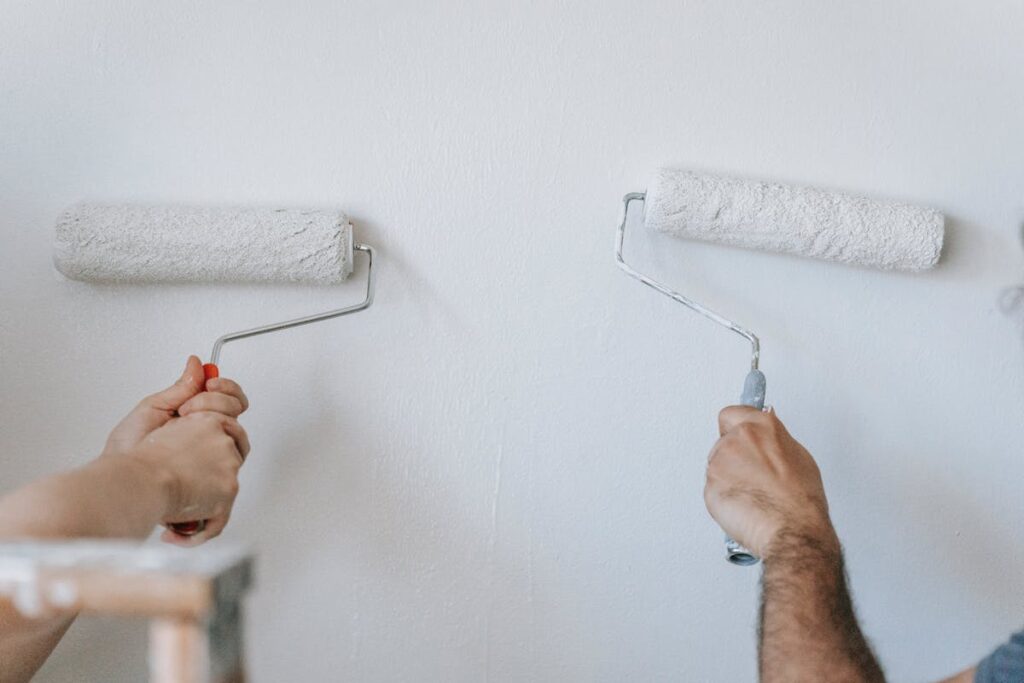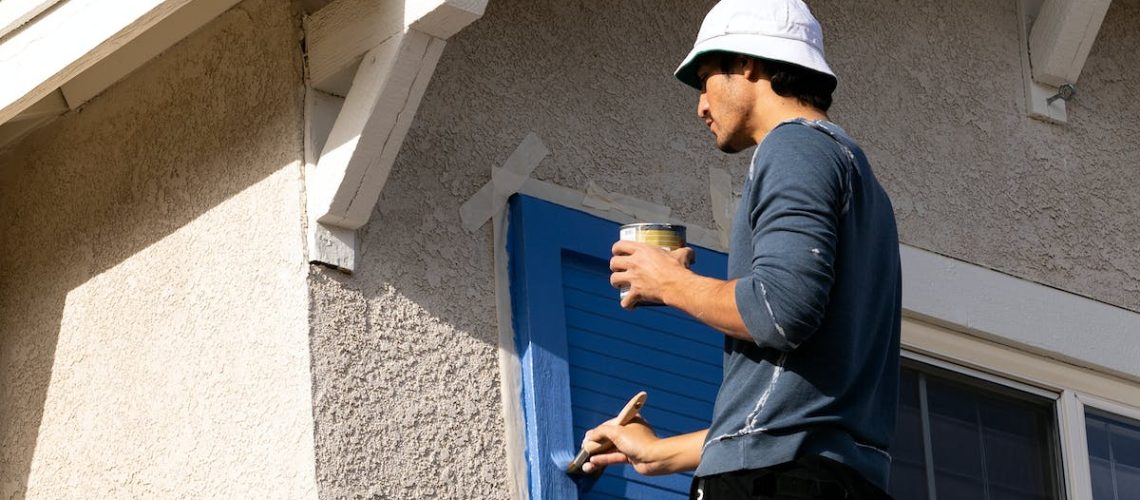A well-done exterior painting job not only enhances the appearance of your home but also increases its value and adds a protective layer against the elements. Conversely, a poorly executed painting job will not only look unsightly but could also lead to costly repairs in the future.
Clearly, exterior painting is more than just about aesthetics. It’s a vital aspect of home maintenance with far-reaching effects on a property’s integrity and value. As such, it is essential that homeowners like you understand the value of proper preparation before painting your outside walls. In this comprehensive guide, we outline the step-by-step process involved in preparing a home for exterior painting in Dublin.
Key Considerations Before You Start Exterior Painting in Dublin
Before you fetch your paintbrush and roller, three critical considerations must be addressed:
Weather Conditions
Dublin’s weather is famously unpredictable and can affect the success of your painting project. Ideally, you should aim for mild temperatures, low humidity, and little to no rain forecasted for at least 48 hours. Planning your exterior painting project around ideal weather will ensure the paint adheres and cures properly.
So, what are the appropriate weather conditions for outdoor house painting in Ireland?
Temperature: The ideal temperature range for exterior latex paints is between 50-90°F. Painting in temperatures higher than 90°F can cause the paint to dry too quickly, whereas colder temperatures below 50°F can inhibit proper curing. Plan your painting for a dry day when daytime temperatures remain steadily within the 50-90° range.
Humidity: Humidity levels greatly influence proper paint application and drying times. Painting when humidity levels exceed 85% will cause the paint to dry too slowly, which allows dust and bugs to collect on the wet paint. For best results, only paint when humidity is below 85% during both application and drying time.
Wind: Strong winds make it difficult to apply paint properly. Wind can blow paint onto surfaces not intended to be coated. Gusty conditions also increase the chance of dust collecting on the wet paint. For flawless paint application, only paint on days when wind speed remains below 15 mph.
Permits
In some cases, local regulations may require you to secure permits before undertaking exterior painting work. Be sure to check with the Dublin City Council and any relevant homeowner’s associations to avoid potential fines or penalties.
Permits are typically needed for:
- Painting a rental property or building with multiple units. This helps ensure proper maintenance and safety standards are met.
- Significant changes in paint colour, especially for historic homes or buildings. This allows the local council to review and approve the aesthetic impact on the neighbourhood.
- Using equipment like scaffolding or lifts for multi-story homes. Safety regulations often require permits in these cases.
- Painting work done near the road, pavement, or public property. Permits help manage the impact on pedestrians and traffic flow.
If you’re painting a single-family home where the colour won’t change significantly, permits are usually unnecessary. But it never hurts to check with your local council, just to be sure. After all, the permit application process is relatively straightforward.
Remember, acquiring any necessary permits upfront will prevent violations or project delays down the road. It shows you’ve done your due diligence as a responsible homeowner.
Paint Quality and Colour
Your choice of paint can make a lot of difference in the final result and the longevity of the paintwork. There are several factors to consider when selecting exterior paint:
Paint Quality: Higher-quality paints contain more pigments and resins, making them more durable and fade-resistant. Look for exterior paints labelled “premium” or “architectural grade.” While they cost more upfront, quality paints will save you money in the long run through increased durability and less frequent repainting. Stay away from the cheapest paints, as they offer poor coverage and wear out quickly.
Paint Finish: The two most common finishes for exterior house paint are satin and flat/matte. Satin offers a smooth, lightly shiny look. It highlights architectural details nicely but also accentuates any imperfections in the siding. Flat/matte paint has no shine and masks flaws well, but it is more prone to collecting dirt and mildew over time. Semi-gloss is best avoided for large areas but useful for doors and trim.
Colour: Colour choice impacts the aesthetics of your home’s exterior and functional factors like heat absorption. Darker colours absorb more heat from sunlight, while lighter colours help reflect heat away. Make sure to get colour samples to test on your house before fully committing to a colour. Neutral and earth-tone shades are good safe choices for most homes’ exteriors.
When purchasing exterior paint, provide the sales associate with details like your home’s siding material, location, architectural style, and preferred finish. This will ensure you get the optimal paint for your particular home and needs. Don’t hesitate to ask questions to find the right balance of quality, colour, and budget.

Exterior Painting in Dublin: Detailed Steps to Prepare Your Home
Now, let’s talk about prep work. Before applying that fresh coat of paint to your house’s exterior walls, it’s crucial to do the groundwork. This involves a series of necessary steps, from cleaning to repair work and, ultimately, priming. These steps aim to provide an ideal surface for the paint to adhere to and should be followed diligently for a successful finish.
Let’s delve into the specifics of each of these preparatory steps for exterior house painting:
Cleaning the Exterior
Begin by thoroughly cleaning the exterior of your home. Not only does this step remove any accumulated dirt, grime, and mildew, but it also ensures a clean and smooth surface for painting.
Use a power washer with a mild detergent solution and work from the top to the bottom of the house. For stubborn stains, a scrub brush may be necessary. Allow the surface to dry completely before proceeding to the next step.
Minor Repairs & Sanding
Inspect the exterior surfaces for damage, such as cracked or peeling paint, holes, rot, or loose siding. Address any issues promptly.
Fill in smaller holes or cracks with a high-quality exterior filler and replace any severely damaged sections. Scrape off any loose or peeling paint using a scraper or wire brush. Sand the affected areas to create a smooth and even surface, ensuring optimal paint adhesion.
Priming
Applying a primer helps create a consistent and even paint job. It’s especially crucial for areas where repairs have been made or for porous surfaces that may require extra protection.
Use an appropriate exterior primer and apply it according to the manufacturer’s recommendations. Allow the primer to dry completely before moving on to the paint application.
Protecting Landscaping and Non-Paint Areas
Before starting the painting process, take the time to protect your landscaping and other non-paint areas. Use drop cloths or plastic sheeting to cover your plants, outdoor furniture, and any other items that may get in the way of your paintwork. Mask off windows, doors, light fixtures, and other surfaces you want to keep paint-free with painter’s tape.

Safety Measures for Exterior Painting in Dublin
Safety is paramount for any project, especially involving work around your home exterior. Here are some safety tips to help you tackle your exterior painting project in Dublin safely:
Use of Personal Protective Equipment (PPE)
Always wear suitable safety gear. This includes safety goggles to protect your eyes from paint splatters and dust, gloves to protect your hands, and a safety mask or respirator to shield you from inhaling any potentially harmful fumes or dust particles.
Proper Ladder Usage
Often, exterior painting jobs require you to work at height. Always ensure the ladder is on a flat, stable surface before you climb. Never overreach when you’re on a ladder. Instead, move the ladder along to stay directly in front of the area you’re working on.
Safe Paint Handling
Paint can be a hazardous substance, especially if not handled correctly. Keep paint out of reach from children and pets. Also, ensure all paint containers are securely sealed when not in use.
Careful With Electrics
Ensure all outdoor electrical outlets are properly covered to prevent paint from seeping into the sockets. Be mindful of overhead power lines when moving ladders and other long equipment.
Ground Cover and Clean-up
It is crucial to cover the ground or plants with a drop cloth to prevent paint spills or debris. It also mitigates the risk of slipping or tripping over paint equipment or debris. Also, make plans about post-project clean up. If you have no time to clean up after painting your walls, you can hire a professional cleaning company.
Rest Periods
Don’t forget to take frequent breaks, especially when working large-scale exterior painting jobs. These rest periods help avoid exhaustion and dehydration, reducing your risk of accidents or mistakes due to fatigue.
By prioritising safety, you’re protecting yourself and ensuring the painting project is a success with minimal complications or accidents.

Common Exterior House Painting Mistakes to Avoid
Embarking on any home improvement project often comes with a learning curve. As such, it is crucial to be aware of potential missteps and mistakes that can compromise your paint job’s quality and durability. Knowing these common errors can help you avoid them and achieve a better result.
Below are some of the usual exterior house painting mistakes amateur painters commit:
Skipping the cleaning step: Failing to clean your home’s exterior before painting can cause poor paint adhesion and a less attractive result.
Neglecting to make repairs: Unaddressed damage can lead to further issues or an uneven paint finish.
Not using primer: Skipping this step can compromise the final appearance and longevity of the paint job.
Rushing the process: Cutting corners or rushing through the preparation steps can lead to unsatisfactory results that may need to be redone sooner than expected.
In conclusion, embarking on an exterior painting project isn’t simply a walk in the park. It demands time, dedication, careful planning, and a fair degree of skill.
Preparing the surface with a thorough cleaning, making necessary repairs, meticulously applying primer, and observing strict safety measures are not just suggestions but prerequisites for a successful result. Moreover, steering clear of common pitfalls adds a layer of insurance against future complications.
While navigating your DIY exterior painting project can indeed be rewarding, it’s worth remembering that professional help is always available. Bringing on board experienced exterior painters in Dublin takes away the stress and complexities of the task. Professionals not only bring years of knowledge, high-quality materials, and specific equipment, but they also complete the job efficiently without compromising quality.
In Dublin, several residential painting companies are available to assist you in transforming your homes with a fresh exterior look. Their expertise ensures that the painting job enhances your home’s curb appeal, standing up to the city’s unpredictable weather and adding value to your property.
Ultimately, the choice to DIY or hire a professional painter lies in your hands. Weigh the pros and cons carefully, taking into account your skill set, the scale of the project, and the time you have available. Whichever route you choose, remember that preparation is key, and calling in the professionals when in doubt is a move toward ensuring success. After all, your home deserves the best coat it can wear!
Need to repaint your walls and improve your home’s curb appeal? For expert exterior painting in Dublin, turn to Painting Dublin – renowned for top-quality, professional services. Contact us today on 086 608 1817 to get a free quote!
Royalty-free image supplied from Pexels as part of the SEO service from 3R
